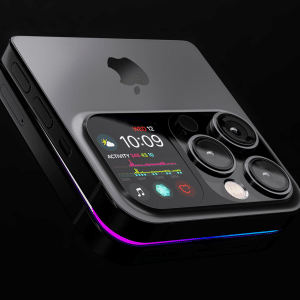On Halloween 1949, Timetreated its readers to an illustrated cover of a mustachioed man surrounded by sleek planes, trains and appliances. Small type read: “Designer Raymond Loewy: He streamlines the sales curve.”
Loewy died in 1986, an undisputed master of industrial design. But his passion for energizing everyday things — from Coke vending machines to the Greyhound bus — lives on in Robert Brunner, 55, who after a notable career at a range of companies, including Apple, is hitting his stride as a creator of objects of desire.
His timing is excellent, as we have returned to a Loewy-esque era, when a product’s compelling look is as important as its flawless function.
“Our understanding of what good design is has matured,” says Brunner. “Five years ago, the heroes were technologists. Today, the heroes are designers building out a user experience. You can have the most amazing technology in the world, but if it’s not put in a form that’s useful and desirable, you won’t be successful.”
Brunner has the artillery to back up that statement. Walk around the offices of Ammunition, his 7-year-old design firm, and you notice most of the computers glow with images of headphones. That’s because the company’s biggest design coup to date is Beats by Dr. Dre, the mushrooming upscale line of audio-related products spearheaded by both the rapper and producing legend Jimmy Iovine. Next week, Brunner and Iovine will be hitting the Consumer Electronics Show in Las Vegas, that annual hot house of envelope-pushing gadget design, to discuss how Beats products can evolve in 2014.
RE-IMAGINING THE HEADPHONE
While Dre and Iovine are responsible for the billion-dollar brainstorm — quality headphones for a generation raised on tinny ear buds — Brunner’s critical stamp involved crafting an elegant single-letter logo on a headphone that dismissed a long-used, complex design architecture reminiscent of small suspension bridges for a simple, yet powerful arc anchored by two padded circles.
“Everything out there didn’t look cool, so Robert helped us create a personality, image and attitude,” says Iovine, who brought Brunner in as a partner in the venture. “We wanted something exciting that could be marketed like a Guns N’ Roses or Nirvana album, like the headphones were the artists. It’s been a great colla-boration.”
But if music isn’t your thing, Brunner has other gadgets whose forms complement their function. Ammunition is responsible for Williams-Sonoma’s first branded line of cookware and utensils, Larklife’s fitness and sleep wristband and Barnes & Noble’s Nook readers. There’s also the Square Stand, which turns an iPad into a point-of-sale device, as well as the Octovo line of leather wallets, bags and smartphone cases.
If this sounds like an eclectic mix, that’s by design.
“We aim to come up with great-looking products that are effective out in the world,” says Brunner, who has little interest in crafting one-off gems prized by a small group of aficionados. “A great piece of work has to have aesthetics, functionality and produce-ability. I say to companies, ‘Give me your business problem, not just your design problem.’ I’m interested in who you are, where you want to be and how I can get you there.”
Loewy said the main goal of industrial design is “not to complicate the already difficult life of the consumer” and instead present pleasing things that make life simpler. But Brunner knows that his success is inextricably linked to more than that.
“As a species, our relationship with things fascinates me,” he says. “Almost everyone has had the experience of falling in love with a thing. It does something, but you also come to cherish and be fascinated by it. That’s what keeps me in business, those emotions. Some businesses don’t get that, because it’s not quantifiable. It’s mysterious.”
NEW DESIGN ERA DAWNS
That said, many companies have gotten the design memo. Whether it’s toothbrushes or smoke detectors, ovens or humidifiers, many of today’s top-selling products tend to have a distinct element of whimsy added to their functionality.
“The simple fact of the matter is, we aren’t as impressed anymore with technological breakthroughs; we care more about how a product makes us feel,” says John Maeda, a graphic artist, computer scientist and artist who is the outgoing president of the Rhode Island School of Design.
“In the old days, buying a computer was like buying a car,” he says. “Today, it’s more like fashion; we consider those products in the same way we consider buying an expensive coat. It’s less about needing it; we want it.” Maeda says applications to RISD are up 10%, something he ascribes to the growing importance of industrial design in all manner of consumer products. Brunner says the competition for young talent is increasingly fierce.
“It’s crazy (for Ammunition) in recruiting and hiring,” says Brunner. “People with design skills are very sought after, so that’s driving our salary structure up.”
The times were decidedly less design-focused when Brunner was coming of age in the ’70s (AMC Pacer anyone?). As the son of Russell Brunner, an engineer who pioneered disc-drive design for IBM, and Elizabeth Brunner, a onetime fashion model turned painter and entrepreneur, Brunner “just grew up thinking that you had to make things.”
A child of Silicon Valley, he went to San Jose State to study civil engineering, but after hearing the compensation was better for electrical engineers, he switched majors. “But I wasn’t happy,” he says.
Until the day he walked past the campus model shop and stopped dead in his tracks. “I thought, ‘I can do that,’ so I switched to being a design major,” he says, then laughs, recalling how his choice angered his father. “He liked to say, ‘Industrial designers are the guys who spec the paint, and then it usually peels off.'”
A PERSONAL TRIUMPH
 In the mid ’80s, Brunner was running his own boutique design firm when he was asked to consult for Apple, which at that point didn’t have an in-house design team. He was persuaded to join Apple in 1989, famously hiring Jony Ive, Apple’s reigning design guru. Although he left Apple in 1997, Brunner says his design philosophy is encapsulated by his crowning achievement: Apple’s breakthrough laptop, the PowerBook.
In the mid ’80s, Brunner was running his own boutique design firm when he was asked to consult for Apple, which at that point didn’t have an in-house design team. He was persuaded to join Apple in 1989, famously hiring Jony Ive, Apple’s reigning design guru. Although he left Apple in 1997, Brunner says his design philosophy is encapsulated by his crowning achievement: Apple’s breakthrough laptop, the PowerBook.
“It is the most important thing I ever worked on there, and it’s a point of pride for me whenever I see that almost every laptop today is patterned off of it,” he says. “The important thing to understand is that it came about through a process of problem solving.”
Brunner says his team had to accommodate the PowerBook’s then-revolutionary rollerball mouse, along with “a keyboard and palm rest. And today, that simple layout remains. We got to that not because we said, ‘We’re going to create a new icon,’ but because we worked the problem. And that’s stuff about design that I love.”
Next up on Brunner’s digital drafting station are a variety of tech-driven projects, ranging from smart-home appliances to helping Dre and Iovine “leverage Beats’ cultural consciousness” to help the brand dive deeper into the lifestyle space.
But if he could pick his own things to tinker with, the designer would find himself treading in Loewy’s maverick shoes.
“I’m a car junkie, but while I did some taxi concepts for New York, it would be great to get to do something like a whole car,” he says. “Also, I haven’t done enough furniture. That whole industry is really rooted back East, but I’d love to do more of that. That’s the classic stuff on a designer’s bucket list — a car, a chair.”
Loewy did both — including a throne-like Barcalounger and a rakish Studebaker Avanti — plus lots more during his 93 years on earth. By that count, Brunner is just getting started.
Martin E. Klimek / USA TODAY














